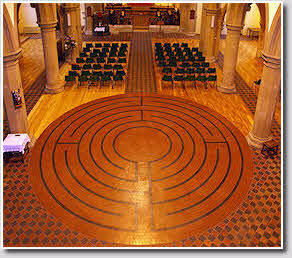LOOK WHAT WE FOUND
 Stopping
off at Abingdon last summer, and revisiting the church of St Michael &
All Angels, we found that a labyrinth had been installed since our last
visit.
Stopping
off at Abingdon last summer, and revisiting the church of St Michael &
All Angels, we found that a labyrinth had been installed since our last
visit.
The labyrinth has a long history in the Christian tradition. Perhaps the best known is the pattern embedded in the floor of Chartres Cathedral in northern France.
During the Middle Ages it was customary for the faithful to vow to make a pilgrimage to Jerusalem. Since travel at that time was both dangerous and expensive, seven cathedrals throughout Europe were designated as alternative sites where pilgrims could journey to fulfil their vows. Chartres was one of these.
The walk into the labyrinth marked the end of the physical journey across the countryside and served as a symbolic entry into the spiritual realm of the Celestial City. A labyrinth belongs to the world of the symbolic: it has a single path with numerous twists and turns that leads eventually to the centre. The centre itself is a sacred place. By navigating all the twists and turns we are invited to reflect upon our own wanderings on our journey through life.
Abingdon’s twin town in Italy is Lucca; there, on the wall outside the Cathedral of San Martino, is a 24 inch finger labyrinth: the pattern is traced with a finger in order to calm the mind before entering the cathedral.
During 2006 it became apparent that the floor of St Michael & All Angels was in very poor condition. Two years later the church was re-ordered: a number of improvements were put in hand and the opportunity was taken to install a labyrinth when the floor was relaid. The design is based on the Abingdon Labyrinth found on an 11th century copy of ‘The consolation of philosophy’ by Boethius, produced at Abingdon Abbey, and now in Cambridge University Library. The Abingdon Labyrinth is an unusual six path, seven wall design.
(Information from the church’s Notes for Visitors)
Roy & Dorothy Smith